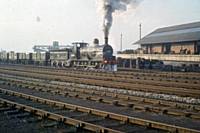'Baggs Yard' Loco Pilots
CASTLETON PILOTS
Castleton , Lancashire boasted a triangular junction where the line from Bolton, Bury and Heywood joined the former L&Y main line to Manchester Victoria. The original name of the township and station was “Blue Pits” but when the township obtained Urban District Council status it was thought more acceptable to change the name to Castleton borrowing the name from an area a mile further east close to Rochdale station.
Prior to 1908 the L&Y had established a sleeper creosoting depot at Castleton and until the late nineteen thirties or early forties it was shunted by an L&Y “Pug” 0-4-0ST. This loco stayed out at Castleton all week from Monday morning to Saturday midday. Within the depot it was single-manned by a driver name Joe Gribaldi who was very proud of his loco and would raise his cap whilst passing through the crowd of waiting passengers at Heywood who could look down on the diminutive loco. For the journeys to and from Bury shed, there had to be a crew of two and a junior fireman was provided to accompany Joe
One morning the loco would not steam. Pressure dropped all the way and whilst they managed to surmount Broadfield bank, the loco expired in the platform at Heywood to the amusement of the waiting passengers. Poor Joe being so proud of his loco was mortified but on checking round, he found that the linkage to the damper had become disconnected. After running repairs the Pug was soon on its way again to the somewhat ironic cheers of the waiting passengers.
Originally known as “Baggs Yard” the sleeper creosoting plant expanded and became a Permanent Way Central Materials Depot (referred to as CMD) . Modernisation came early and a small Fowler diesel shunter number ED6 was given the job of Castleton CMD pilot and lived in its own little shed. However by the fifties number ED6 was more often absent than present and whilst the Ian Allan loco shed books at various times claimed that ED1 and ED5 were at Castleton, I never saw either there although ED1 was once visible poking out of the back of Newton Heath shed for a lengthy period.
When steam had to deputise Bury shed would send up a suitable loco. There was also an all day “Mainline Pilot” at Castleton. L&Y 0-6-0STs and L&Y “A” class 0-6-0s were the mainstay of shunting locos in the fifties although the former were rarely seen after the middle of the decade.
The L&Y “A” classes included Number 52129 with an ancient tender off an old Barton-Wright 4-4-0 loco, 52523 with a 2000 gallon tender off a Barton Wright 0-6-0 which had been rebuilt as a saddletank and Belpaire locomotive Number 52201. Number 52201 came to Bury shed after the stud of twelve L&Y “A” class 0-6-0s and the three L&Y 0-6-0STs which had done service as Crewe Works shunters were replaced by LMS 4F 0-6-0s.
Bury shed had a stud of Ivatt 2MT 2-6-0s and these were popular locomotives for Castleton pilot jobs. The shed only ever had a small allocation of 4F 0-6-0s, such as 43880, 43913 and 44092, similarly with Jinties so the appearance of these two classes at Castleton was not very frequent although I do remember one sunny spring morning being rather late for work after riding the footplate of number 43880 the mile from Castleton Yard to the coal yard at Bradford Street on the outskirts of Rochdale known as “Castleton Sidings”.
There were various attempts to cover the CMD pilot job with small diesel shunters such as a Drewry or a Barclay but eventually BR gave up the struggle and provided an 08 shunter. In 1957 a rail welding depot was established at Castleton which functioned very successfully until 2008 when Corus removed the plant to Scunthorpe. At first the trains of longwelded rail were sent out on the often lengthy journeys to site behind 08s as it was feared that any speed higher than 15 mph might be too dangerous but it was soon realised that higher speeds were not likely to cause derailments.
In 1966 various British Railways Standard class 2 2-6-0s made redundant elsewhere on the system such as 78007 and 78002 , were sent into the area to work out their withdrawal mileage and were to be seen at Castleton.
When Bury shed closed responsibility for providing the pilots passed to Bolton shed and towards the end of steam only larger locomotives such as Black Fives were left. Number 45104 on 29 June 1968 was the last steam Castleton Mainline pilot. All remaining Manchester steam sheds (Newton Heath, Bolton and Patricroft) closed that weekend. Late on Friday 28 June 44871 worked Bolton to Goole freight returning on the Healey Mills to Bolton early on 29 June. A further steam loco running light en route to Bolton shed passed Castleton later that day.
This wasn’t the end of BR steam at Castleton as until 2 August Mondays to Fridays a Rose Grove loco usually a Stanier 8F 2-8-0 (occasionally the later to be preserved 48773) would power the Burnley to Moston freight via Blackburn, Bolton and Castleton North to South Junctions. Then it returned to Rose Grove with a freight from Brewery Sidings via Castleton South to East Junctions, Littleborough and Todmorden.
Some time during the night of 2nd/3rd August 1968, Black Five 4-6-0 45158 having been in charge of a Friday night holiday extra from Blackburn to the South as far as Stockport returned light engine to Rose Grove shed via Castleton and Littleborough. Whether 45158 had earlier taken the coaches from Lightbowne Carriage Sidings (Newton Heath) to Blackburn and if it did via which route is not known.
Sunday 4th August saw the last BR steam at Castleton when 8F 48476 and Standard 5MT 73069 was routed via Oldham, Rochdale and Bury on an enthusiasts’ special.
That was supposed to be the very end but Standard 5MT 73050 went under steam light engine from Newton Heath shed (by then a diesel depot) to Peterborough for preservation on 19th September 1968. It ran twenty minutes early so I missed photographing it.
My eternal regret is that I missed photographing number 47165, a Fowler 0-6-0T Dock Tank which did one day’s duty at Castleton about 1965. A friend who commuted by train passed the yard and saw it but as the number commenced with 47 he thought it was just a Jinty.
11 January 2020 RSG

